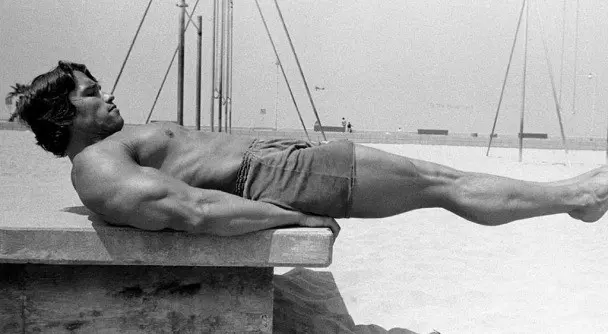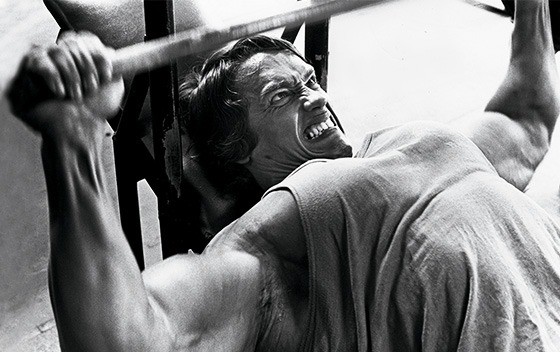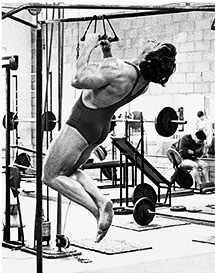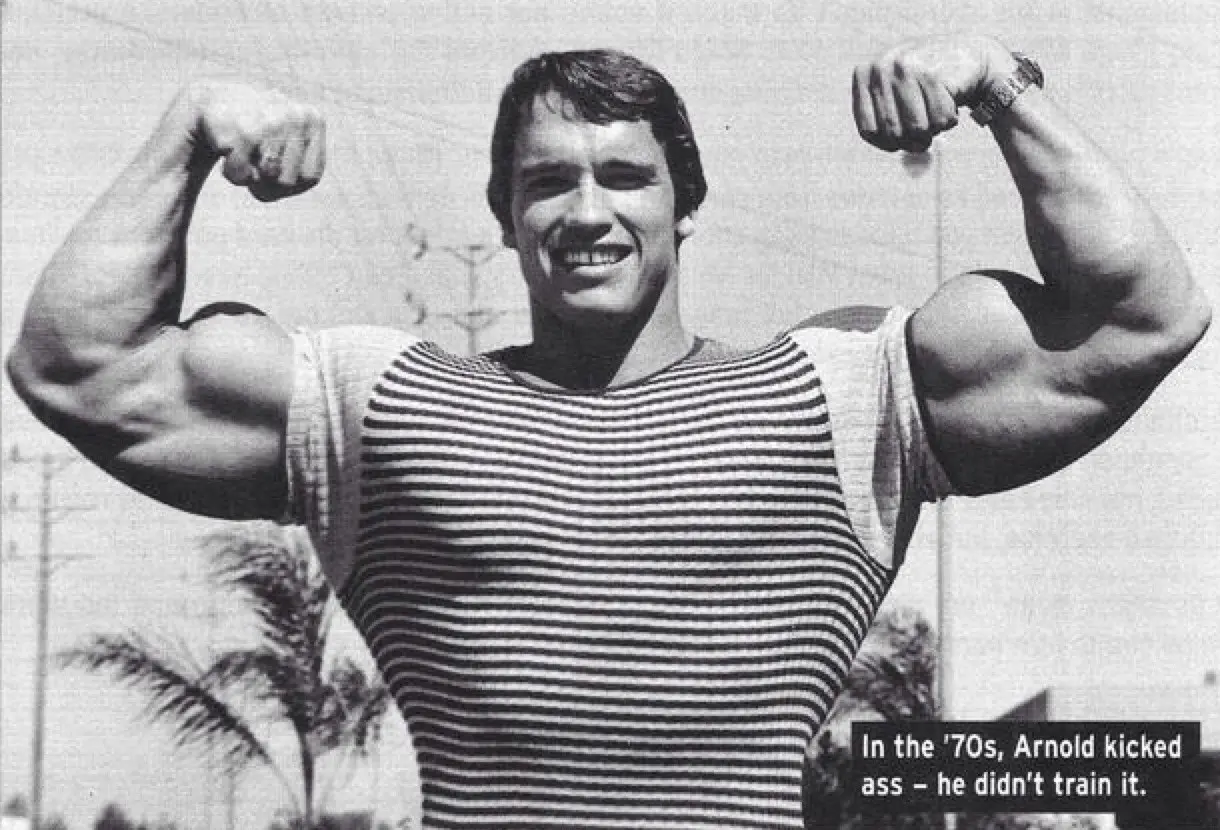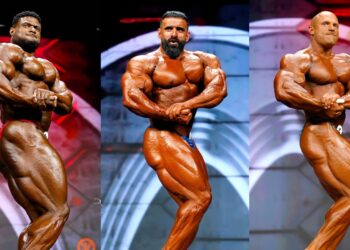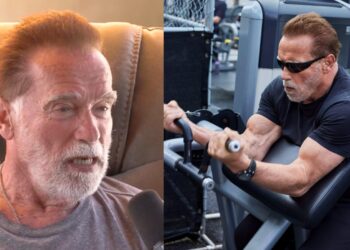When it comes to chest and back training, Arnold was all about supersets, his philosophy could be described as ‘pair and pair alike.’ It worked.
After all of the box-office successes (and failures), all of the State of the State speeches and ballot initiatives, all of the fame and fortune, its easy to forget that at his very core Arnold Schwarzenegger is, first and foremost, a gym rat.
Long before he ever uttered a one-liner or sparred with a hostile legislature, the five-time Mr. Universe and seven-time Mr. Olympia spent untold hours toiling away in shoebox-size gyms across the globe, pushing, pulling, and pumping iron. His efforts aimed to become the best bodybuilder on the planet, and it was a goal he achieved year after competitive year throughout the 1960s and ’70s.
Ever the student, Arnold continually honed his skills, applying the same rigorous discipline to his gym work as he later would to his film and political careers. Just as important, he was fearless (another common Schwarzenegger theme) in his training. While many of his bodybuilding peers were content to follow the staid dictums that had been laid out decades earlier with blind obedience, Arnold always looked for ways to up the intensity.
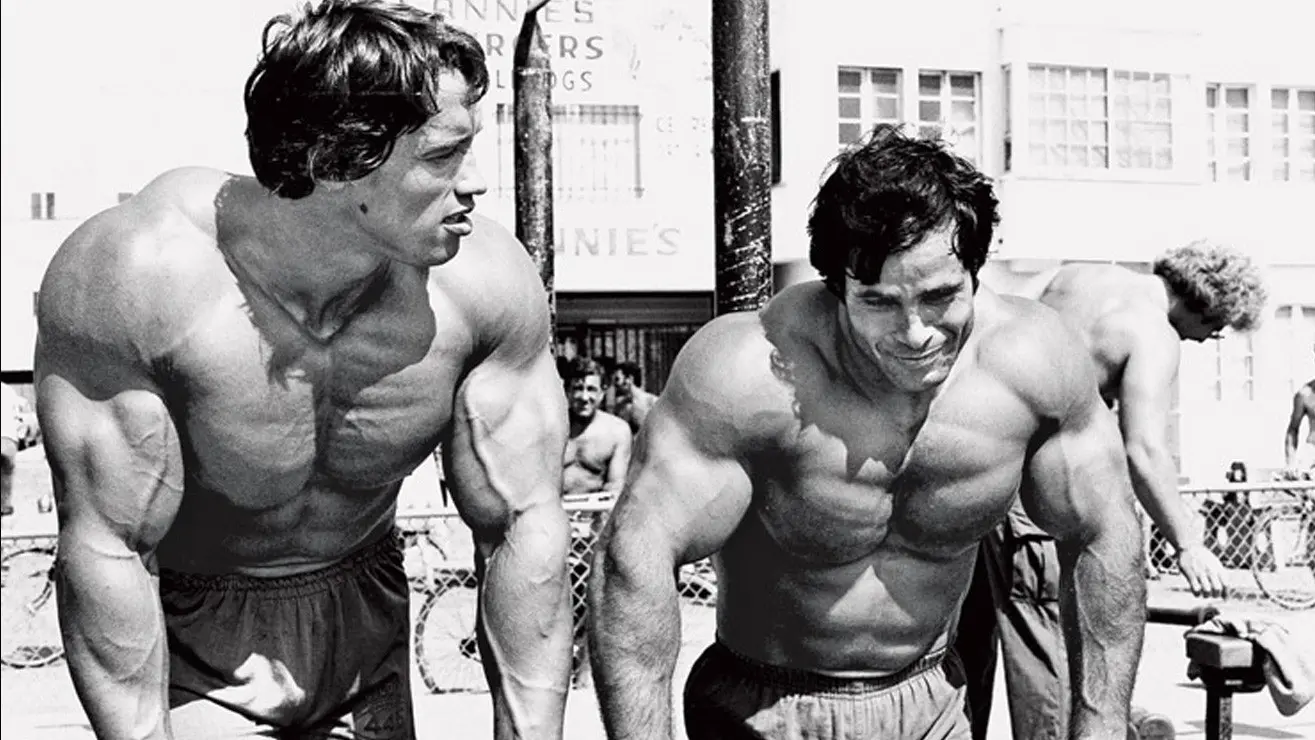
Arnold began scouring Muscle Builder (the forebear to Muscle & Fitness) for ways to amp up his workouts and eventually discovered the Weider Principles—a compendium of techniques designed to increase workout intensity.
Level Up Your Fitness: Join our 💪 strong community in Fitness Volt Newsletter. Get daily inspiration, expert-backed workouts, nutrition tips, the latest in strength sports, and the support you need to reach your goals. Subscribe for free!
By the end of the ’60s, he hit upon a formula to his liking—one that involved six days of training twice a day and featured several Weider Principles, including his favorite: Supersets.
Ready… Superset… Go!
Why Back & Chest
“One of the most important reasons why a chestback superset program works so well is the fact that most chest exercises are pushing movements, while all back exercises are pulling exercises. The chest muscles are resting during the lats exercise and the lats are resting during the chest movement. While each muscle is alternately resting and working, it stays fully flushed and pumped up…. When the chest and upper back are pumped simultaneously, there is an indescribable feeling of growth stimulation and massiveness.”
-Arnold Schwarzenegger
Supersetting involves the grouping of two or more exercises performed in sequence without rest. There are two ways of super setting: one that groups exercise for the same body part, and another that pairs exercises for opposing body parts. Arnold was a fan of both variations, and he applied super setting most faithfully to his chest-back workout.
“There are several advantages to alternating chest and back exercises,”
He has said on multiple occasions:
- It saves time and the workout goes much faster.
- You can handle heavier poundage, for more mass and power.
- You get a greater pump and a continuous flushing effect of both areas for the entire workout, and you keep the pump longer.
- Greater muscle-density results because you can work to the absolute limit of your physical capacity.
In his seminal training tome, The New Encyclopedia of Modern Bodybuilding, Arnold explains in detail the benefits of chest-back supersetting.
The Routine
Arnold’s chest/back routine consists of nine exercises—four for chest and four for the back, followed by dumbbell pullovers, which is a combination exercise that works the lats while stretching the pecs. In total it’s 45 working sets done with no rest during the supersets and only a minute or so between supersets, after which he would spend a few minutes forcefully flexing the muscle groups he had just trained.
From start to finish the workout takes about 45 minutes, and by the end of it the Austrian Oak would be drenched in sweat and gasping for air. Legend has it that Gold’s Gym would keep an oxygen tank on hand to assist Arnold and his training partners in making it through such physically taxing workouts.

to an improbable 57 inches, due in large part to pecs and a back that still rank among the best in bodybuilding history.
While following Arnold’s chest-back routine may not give you a jacket size greater than the average woman’s height, it should prove a grueling but effective way to add quality mass to your torso.
Arnold’s Double-Split Routine:
Nowadays, few bodybuilders perform double-split routines, believing that two workouts per day will overtax the body. It didn’t seem to do Arnold any harm, though, and the double split wound up being de rigueur for most of the pros who trained at gold’s gym in Venice, CA, during its halcyon days of the 1970s.
Morning:
- DAY 1: Chest, Back
- DAY 2: Shoulders, Arms
- DAY 3: Chest, Back
- DAY 4: Shoulders, Arms
- DAY 5: Chest, Back
- DAY 6: Shoulders, Arms
- DAY 7: OFF
Evening:
- DAY 1: Thighs, Calves, Abs
- DAY 2: Calves, Abs
- DAY 3: Thighs, Calves, Abs
- DAY 4: Calves, Abs
- DAY 5: Thighs, Calves, Abs
- DAY 6: Calves, Abs
- DAY 7: OFF
Superset #1
Barbell Bench Press + Wide-Grip Behind-the-Neck Chin
The first superset of the routine would begin with a warmup of 30–45 reps on the bench with 135 pounds, followed by 15 chins. For the next five sets, Arnold would shuttle back and forth between bench presses and chins, pyramiding up in weight for the bench press while reducing reps for both the bench and chin. Typically, his rep scheme would be 15, 15, 12, 8, 6 for each exercise. It’s worth noting that Arnold was diligent about his breathing and made sure to take extra deep breaths during this particular superset.
Level Up Your Fitness: Join our 💪 strong community in Fitness Volt Newsletter. Get daily inspiration, expert-backed workouts, nutrition tips, the latest in strength sports, and the support you need to reach your goals. Subscribe for free!
Superset #2
Incline Barbell Press + T-Bar Row
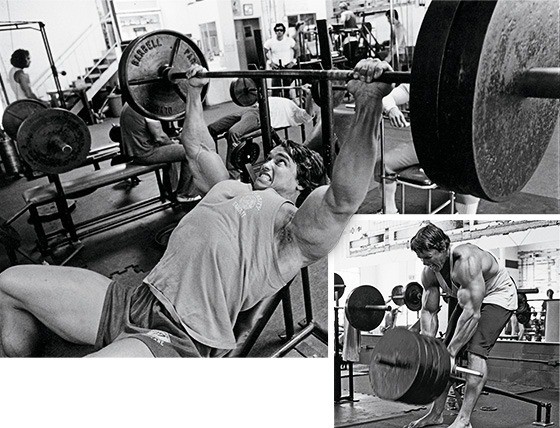
Superset #3
Flat-Bench Dumbell + Wide-Grip Barbell Row
Arnold was a master of training technique, and nowhere was this more evident than in the way he performed dumbbell flyes.
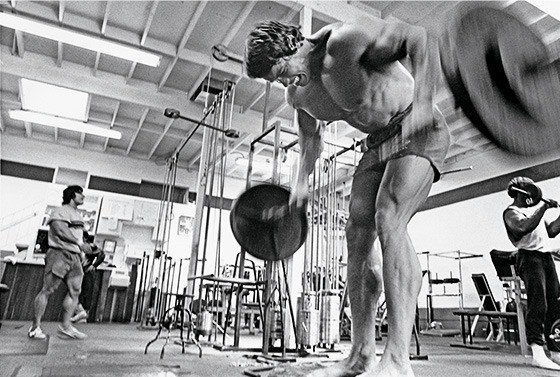
Similarly, for barbell rows he’d stand on a bench or high box—the better to get a full stretch at the bottom—and, with his torso nearly parallel to the floor, perform picture-perfect reps. No jerking the weight for him; it was all back taking the load.
Typically, he would perform sets of 15, 12, 10, 10, and 10 reps for each exercise.
10-second tip: Imitate Arnold’s Form on barbell rows by keeping your torso more or less parallel to the floor, even at the top of the rep.
Superset #4
Weighted Dip + Close-Grip Chin
By this point, Arnold would be sucking wind pretty good. He’d have been at it for more than a half hour, and the dual pump in his pecs and lats would be stretching his tank top. Still, he would soldier on.
He’d strap a dumbbell weighing as much as 80 pounds around his waist and aim for 15 reps in each of the five sets of dips. For the close-grip chins, he preferred using a v-bar attachment that he’d drape over the overhead bar. If none were to be found, he’d take a narrow, overhand grip and shoot for five sets of 12 reps.
The Finale: Stiff-arm Pullover
Whether one can actually expand the rib cage via exercise is open to debate, but Arnold believed it and so performed pullovers throughout his bodybuilding career.
The fact is, regardless of its purported rib cage–expanding properties, the pullover is an excellent exercise for targeting both the lats and the hard-to-reach serratus, and for providing the pecs with a great stretch.
Arnold liked to lie across the bench to better sink his hips toward the floor and get an even stretch throughout the thoracic region.
“You’ll not believe the ache in the sternum that this movement will produce!” Arnold said. “It literally pulls your chest apart and forces it into new growth.”
Despite his state of near-total fatigue, he’d knock out five sets of 15–20 full, breathing-intensive reps to finish the workout.
235 lbs: Arnold’s average competition weight when he won his Mr. Olmpia titles.
Post-Workout
Iso-tension Contractions Arnold always finished up his workouts with a few minutes of flexing and posing. He liked the idea of further flooding each body part with oxygen-rich blood, and he believed this gave his muscles a harder, more defined look that would carry over to onstage success.
Finally, after 45 minutes and a few pounds of lost sweat, Arnold’s morning workout
was done.
“As I head for the shower, I feel exhausted but exhilarated, like a boxer who has just gone 15 rounds with the heavyweight champion and beaten him with a knockout in the final round!”
By: Flex Magazine
Copyright 2008 Weider Publications

